Risk Management in Water Supply Network Development: A Report
VerifiedAdded on 2020/03/16
|25
|6317
|195
Report
AI Summary
This report delves into the critical aspects of risk management within the context of water supply network development, focusing on the United Arab Emirates, particularly Dubai. It emphasizes the importance of proactive risk analysis and treatment processes to mitigate potential issues during the implementation of water pipeline networks. The report outlines key issues such as location selection, financial risks, lack of training, protective equipment deficiencies, and time management risks. It then details significant features of effective risk management processes, including risk identification, analysis, prioritization, and strategy development. The report also identifies various risks associated with water pipeline development, categorizing them by type and impact, and discusses risk management techniques and treatment strategies, including avoidance, mitigation, transfer, and retention. The report concludes with a discussion of risk management and organizational culture and the identification of standards of risk management, referencing ISO 31000 as a benchmark for best practices.
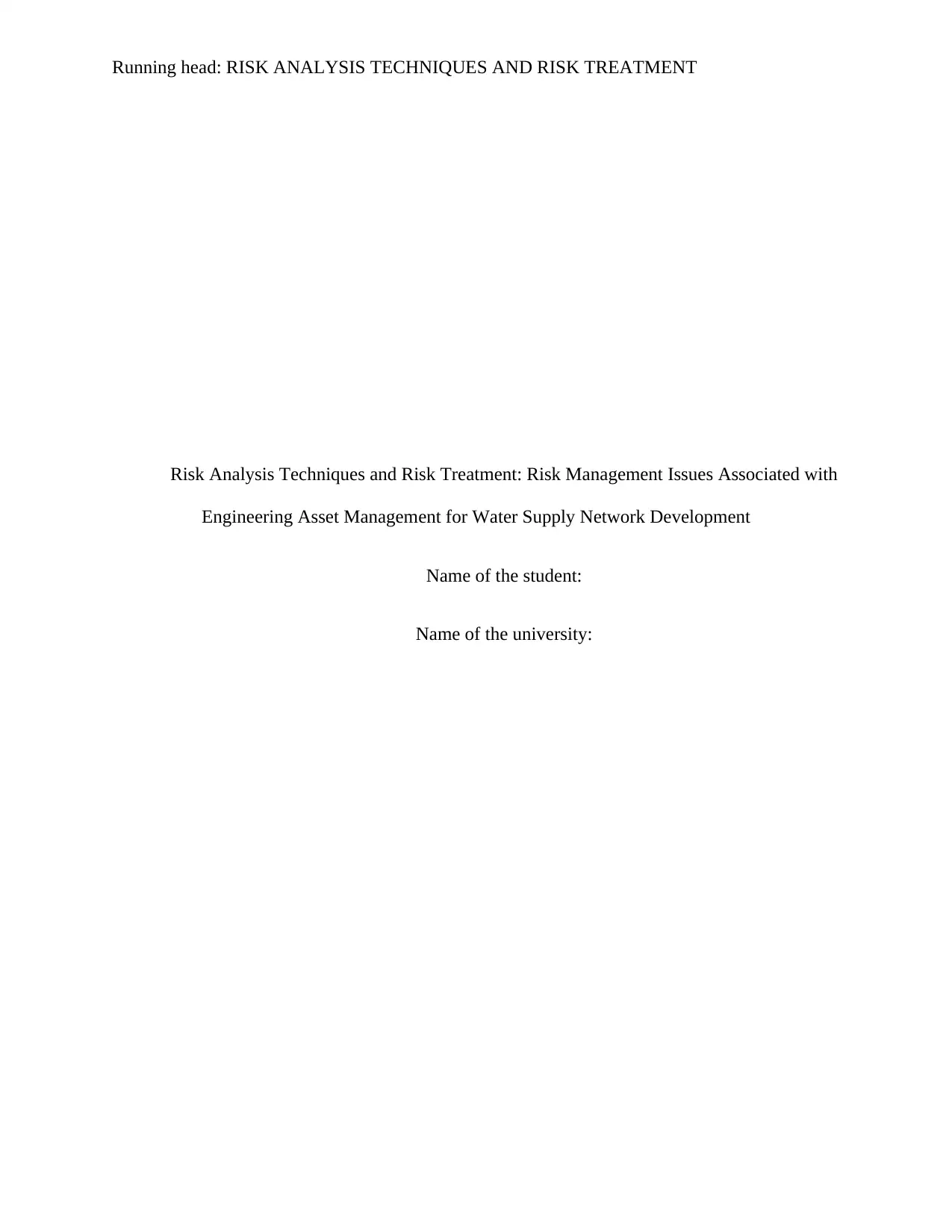
Running head: RISK ANALYSIS TECHNIQUES AND RISK TREATMENT
Risk Analysis Techniques and Risk Treatment: Risk Management Issues Associated with
Engineering Asset Management for Water Supply Network Development
Name of the student:
Name of the university:
Risk Analysis Techniques and Risk Treatment: Risk Management Issues Associated with
Engineering Asset Management for Water Supply Network Development
Name of the student:
Name of the university:
Paraphrase This Document
Need a fresh take? Get an instant paraphrase of this document with our AI Paraphraser
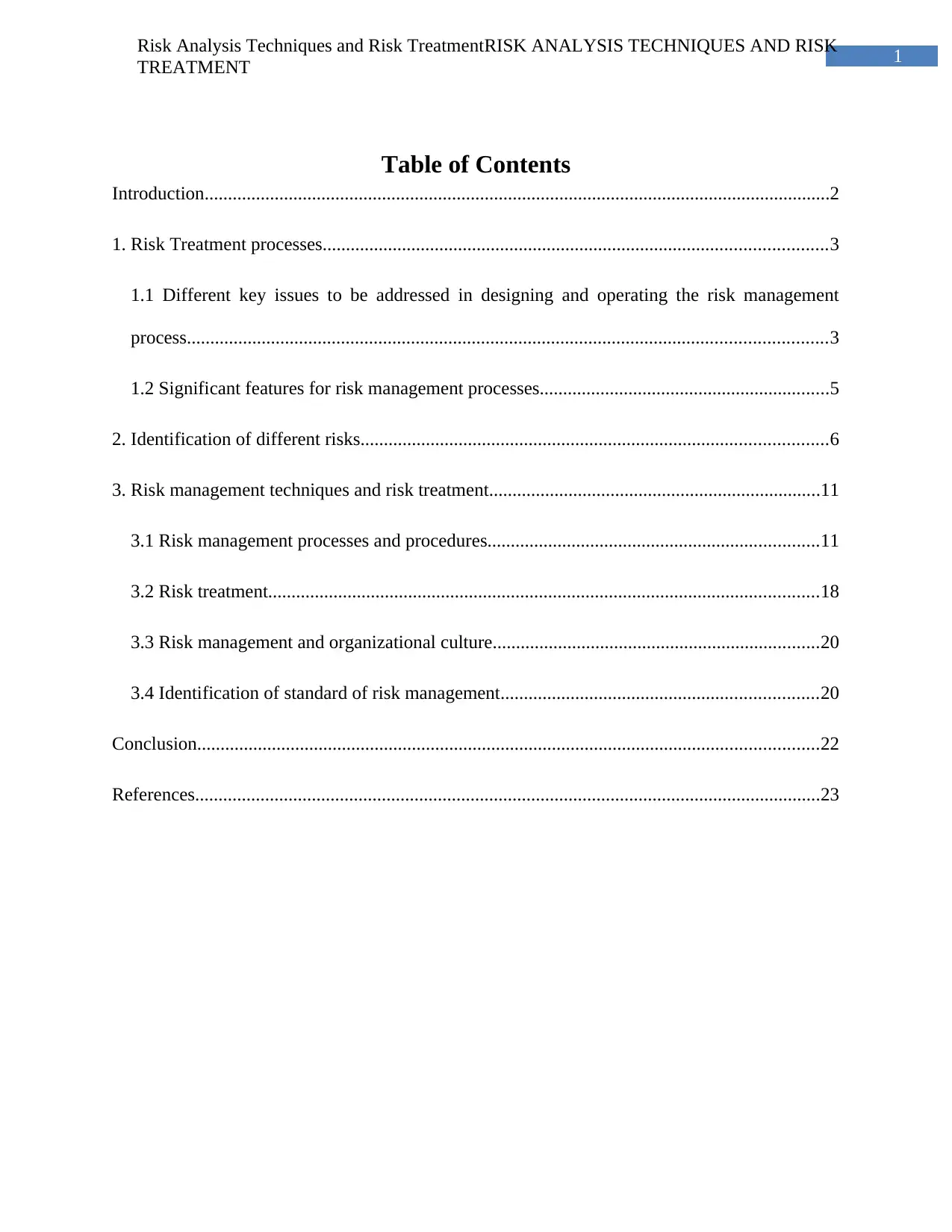
1
Risk Analysis Techniques and Risk TreatmentRISK ANALYSIS TECHNIQUES AND RISK
TREATMENT
Table of Contents
Introduction......................................................................................................................................2
1. Risk Treatment processes............................................................................................................3
1.1 Different key issues to be addressed in designing and operating the risk management
process.........................................................................................................................................3
1.2 Significant features for risk management processes..............................................................5
2. Identification of different risks....................................................................................................6
3. Risk management techniques and risk treatment.......................................................................11
3.1 Risk management processes and procedures.......................................................................11
3.2 Risk treatment......................................................................................................................18
3.3 Risk management and organizational culture......................................................................20
3.4 Identification of standard of risk management....................................................................20
Conclusion.....................................................................................................................................22
References......................................................................................................................................23
Risk Analysis Techniques and Risk TreatmentRISK ANALYSIS TECHNIQUES AND RISK
TREATMENT
Table of Contents
Introduction......................................................................................................................................2
1. Risk Treatment processes............................................................................................................3
1.1 Different key issues to be addressed in designing and operating the risk management
process.........................................................................................................................................3
1.2 Significant features for risk management processes..............................................................5
2. Identification of different risks....................................................................................................6
3. Risk management techniques and risk treatment.......................................................................11
3.1 Risk management processes and procedures.......................................................................11
3.2 Risk treatment......................................................................................................................18
3.3 Risk management and organizational culture......................................................................20
3.4 Identification of standard of risk management....................................................................20
Conclusion.....................................................................................................................................22
References......................................................................................................................................23
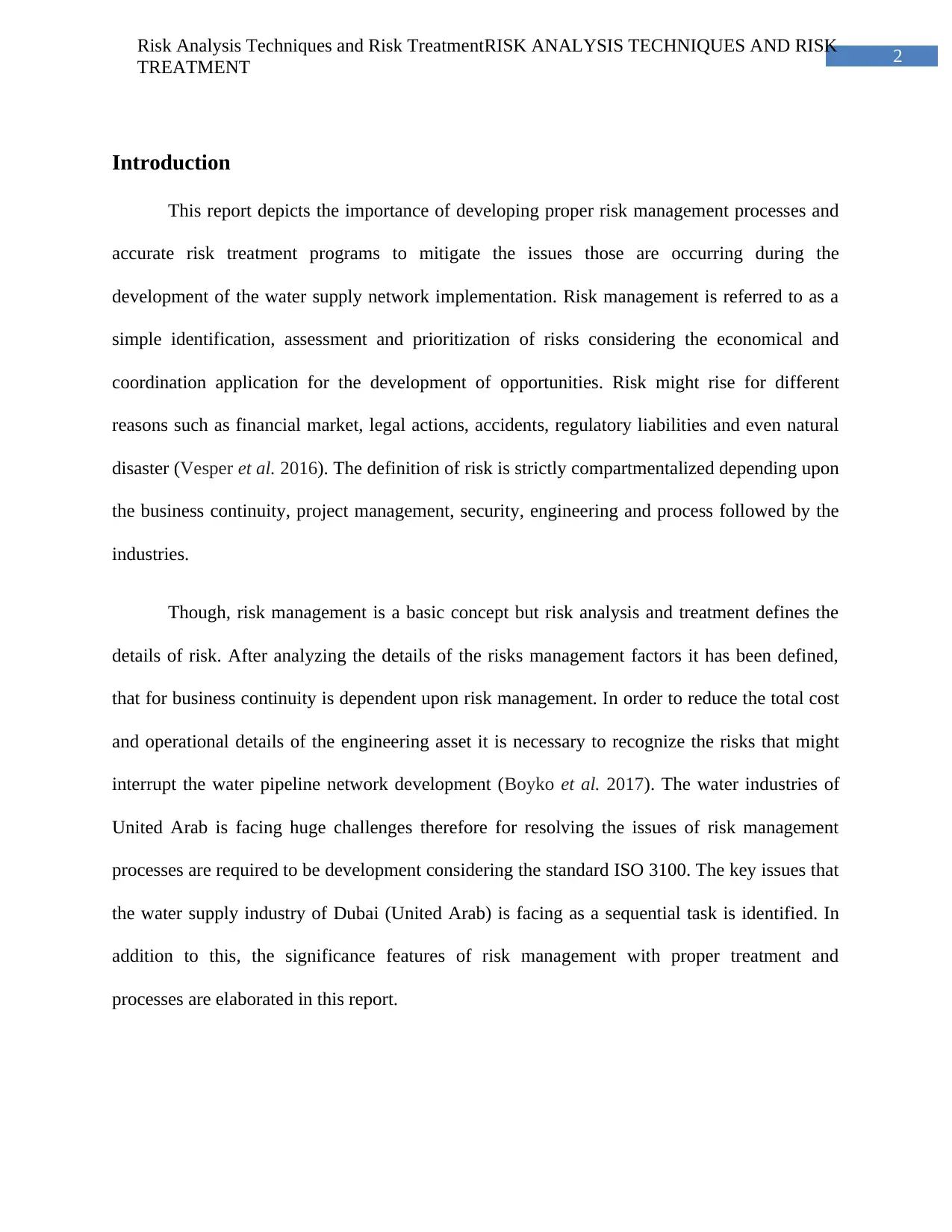
2
Risk Analysis Techniques and Risk TreatmentRISK ANALYSIS TECHNIQUES AND RISK
TREATMENT
Introduction
This report depicts the importance of developing proper risk management processes and
accurate risk treatment programs to mitigate the issues those are occurring during the
development of the water supply network implementation. Risk management is referred to as a
simple identification, assessment and prioritization of risks considering the economical and
coordination application for the development of opportunities. Risk might rise for different
reasons such as financial market, legal actions, accidents, regulatory liabilities and even natural
disaster (Vesper et al. 2016). The definition of risk is strictly compartmentalized depending upon
the business continuity, project management, security, engineering and process followed by the
industries.
Though, risk management is a basic concept but risk analysis and treatment defines the
details of risk. After analyzing the details of the risks management factors it has been defined,
that for business continuity is dependent upon risk management. In order to reduce the total cost
and operational details of the engineering asset it is necessary to recognize the risks that might
interrupt the water pipeline network development (Boyko et al. 2017). The water industries of
United Arab is facing huge challenges therefore for resolving the issues of risk management
processes are required to be development considering the standard ISO 3100. The key issues that
the water supply industry of Dubai (United Arab) is facing as a sequential task is identified. In
addition to this, the significance features of risk management with proper treatment and
processes are elaborated in this report.
Risk Analysis Techniques and Risk TreatmentRISK ANALYSIS TECHNIQUES AND RISK
TREATMENT
Introduction
This report depicts the importance of developing proper risk management processes and
accurate risk treatment programs to mitigate the issues those are occurring during the
development of the water supply network implementation. Risk management is referred to as a
simple identification, assessment and prioritization of risks considering the economical and
coordination application for the development of opportunities. Risk might rise for different
reasons such as financial market, legal actions, accidents, regulatory liabilities and even natural
disaster (Vesper et al. 2016). The definition of risk is strictly compartmentalized depending upon
the business continuity, project management, security, engineering and process followed by the
industries.
Though, risk management is a basic concept but risk analysis and treatment defines the
details of risk. After analyzing the details of the risks management factors it has been defined,
that for business continuity is dependent upon risk management. In order to reduce the total cost
and operational details of the engineering asset it is necessary to recognize the risks that might
interrupt the water pipeline network development (Boyko et al. 2017). The water industries of
United Arab is facing huge challenges therefore for resolving the issues of risk management
processes are required to be development considering the standard ISO 3100. The key issues that
the water supply industry of Dubai (United Arab) is facing as a sequential task is identified. In
addition to this, the significance features of risk management with proper treatment and
processes are elaborated in this report.
⊘ This is a preview!⊘
Do you want full access?
Subscribe today to unlock all pages.

Trusted by 1+ million students worldwide
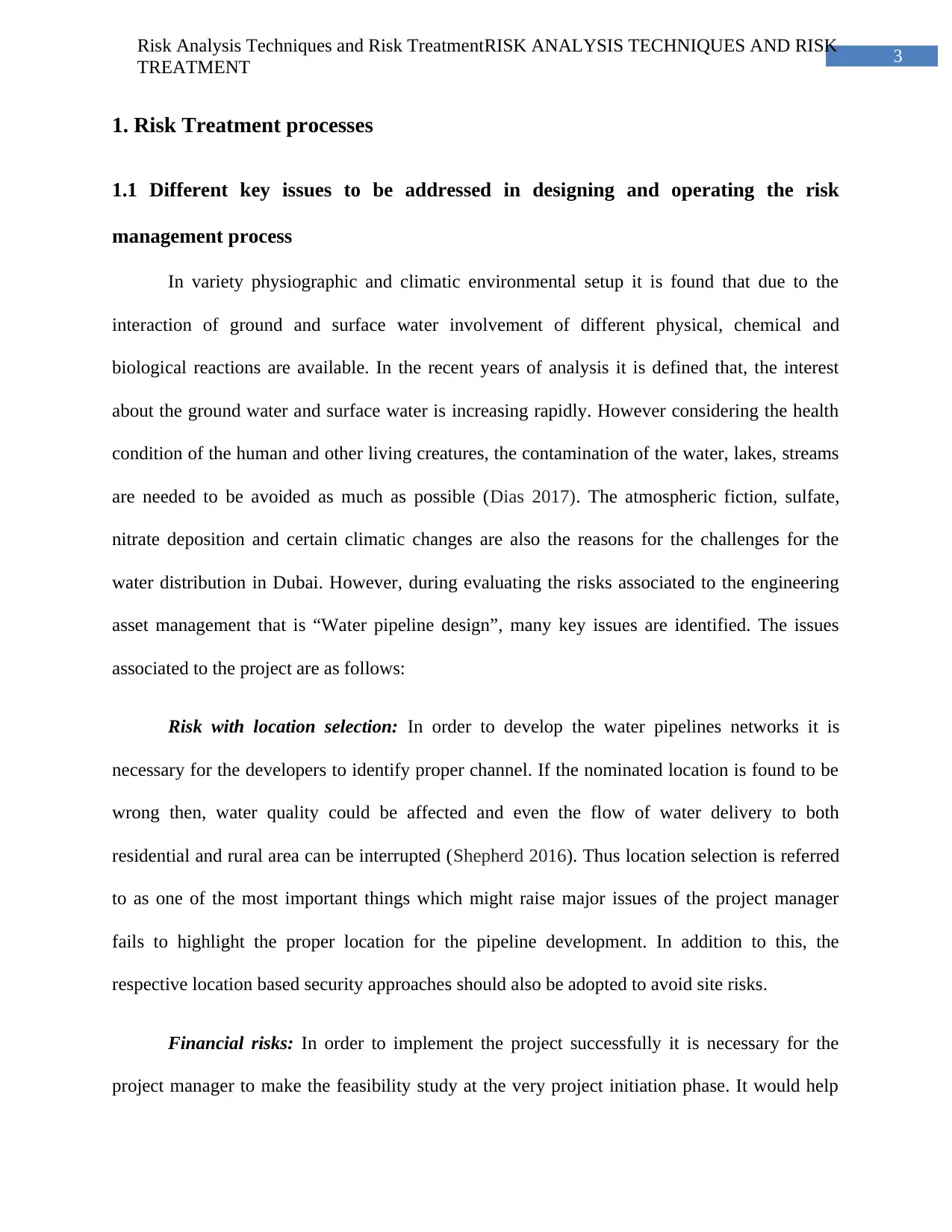
3
Risk Analysis Techniques and Risk TreatmentRISK ANALYSIS TECHNIQUES AND RISK
TREATMENT
1. Risk Treatment processes
1.1 Different key issues to be addressed in designing and operating the risk
management process
In variety physiographic and climatic environmental setup it is found that due to the
interaction of ground and surface water involvement of different physical, chemical and
biological reactions are available. In the recent years of analysis it is defined that, the interest
about the ground water and surface water is increasing rapidly. However considering the health
condition of the human and other living creatures, the contamination of the water, lakes, streams
are needed to be avoided as much as possible (Dias 2017). The atmospheric fiction, sulfate,
nitrate deposition and certain climatic changes are also the reasons for the challenges for the
water distribution in Dubai. However, during evaluating the risks associated to the engineering
asset management that is “Water pipeline design”, many key issues are identified. The issues
associated to the project are as follows:
Risk with location selection: In order to develop the water pipelines networks it is
necessary for the developers to identify proper channel. If the nominated location is found to be
wrong then, water quality could be affected and even the flow of water delivery to both
residential and rural area can be interrupted (Shepherd 2016). Thus location selection is referred
to as one of the most important things which might raise major issues of the project manager
fails to highlight the proper location for the pipeline development. In addition to this, the
respective location based security approaches should also be adopted to avoid site risks.
Financial risks: In order to implement the project successfully it is necessary for the
project manager to make the feasibility study at the very project initiation phase. It would help
Risk Analysis Techniques and Risk TreatmentRISK ANALYSIS TECHNIQUES AND RISK
TREATMENT
1. Risk Treatment processes
1.1 Different key issues to be addressed in designing and operating the risk
management process
In variety physiographic and climatic environmental setup it is found that due to the
interaction of ground and surface water involvement of different physical, chemical and
biological reactions are available. In the recent years of analysis it is defined that, the interest
about the ground water and surface water is increasing rapidly. However considering the health
condition of the human and other living creatures, the contamination of the water, lakes, streams
are needed to be avoided as much as possible (Dias 2017). The atmospheric fiction, sulfate,
nitrate deposition and certain climatic changes are also the reasons for the challenges for the
water distribution in Dubai. However, during evaluating the risks associated to the engineering
asset management that is “Water pipeline design”, many key issues are identified. The issues
associated to the project are as follows:
Risk with location selection: In order to develop the water pipelines networks it is
necessary for the developers to identify proper channel. If the nominated location is found to be
wrong then, water quality could be affected and even the flow of water delivery to both
residential and rural area can be interrupted (Shepherd 2016). Thus location selection is referred
to as one of the most important things which might raise major issues of the project manager
fails to highlight the proper location for the pipeline development. In addition to this, the
respective location based security approaches should also be adopted to avoid site risks.
Financial risks: In order to implement the project successfully it is necessary for the
project manager to make the feasibility study at the very project initiation phase. It would help
Paraphrase This Document
Need a fresh take? Get an instant paraphrase of this document with our AI Paraphraser
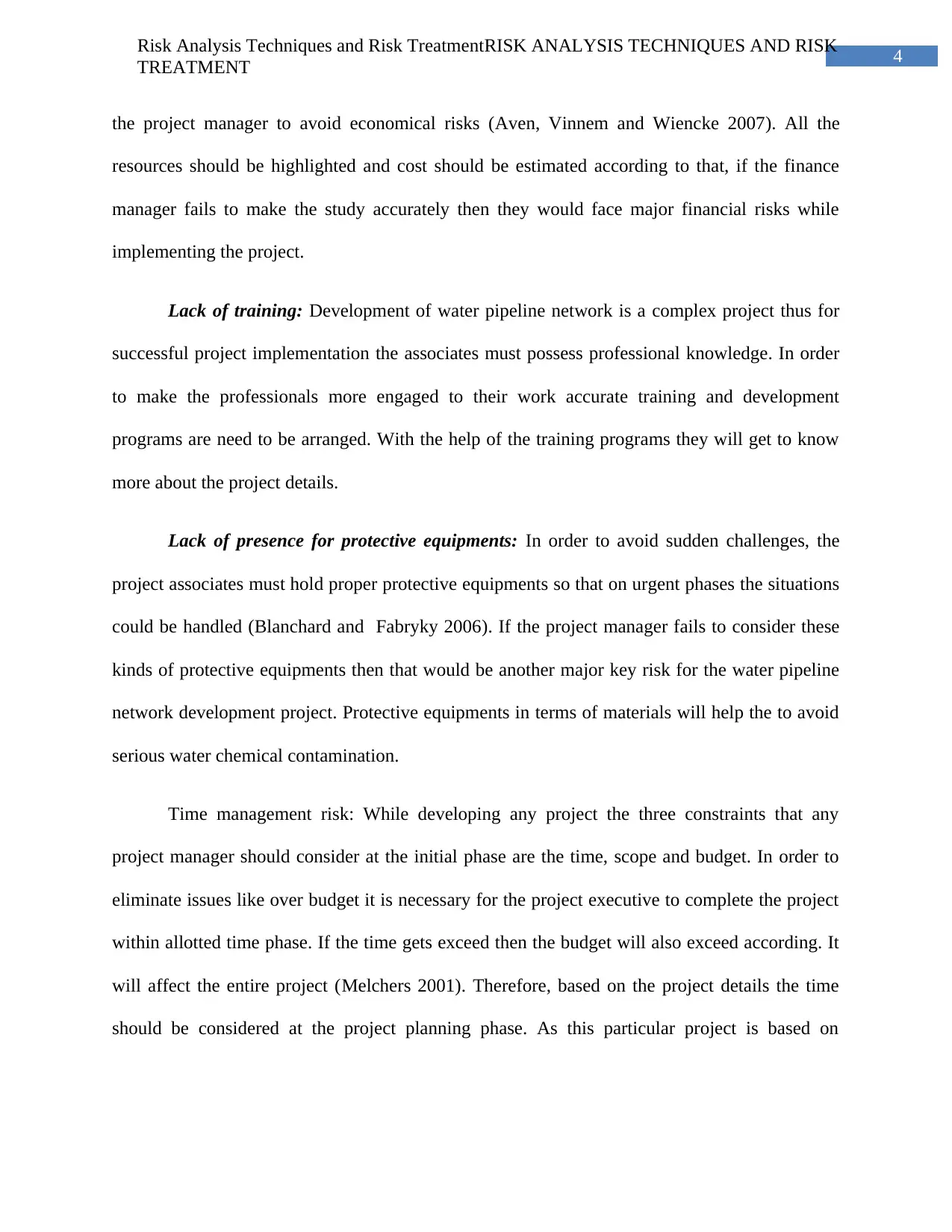
4
Risk Analysis Techniques and Risk TreatmentRISK ANALYSIS TECHNIQUES AND RISK
TREATMENT
the project manager to avoid economical risks (Aven, Vinnem and Wiencke 2007). All the
resources should be highlighted and cost should be estimated according to that, if the finance
manager fails to make the study accurately then they would face major financial risks while
implementing the project.
Lack of training: Development of water pipeline network is a complex project thus for
successful project implementation the associates must possess professional knowledge. In order
to make the professionals more engaged to their work accurate training and development
programs are need to be arranged. With the help of the training programs they will get to know
more about the project details.
Lack of presence for protective equipments: In order to avoid sudden challenges, the
project associates must hold proper protective equipments so that on urgent phases the situations
could be handled (Blanchard and Fabryky 2006). If the project manager fails to consider these
kinds of protective equipments then that would be another major key risk for the water pipeline
network development project. Protective equipments in terms of materials will help the to avoid
serious water chemical contamination.
Time management risk: While developing any project the three constraints that any
project manager should consider at the initial phase are the time, scope and budget. In order to
eliminate issues like over budget it is necessary for the project executive to complete the project
within allotted time phase. If the time gets exceed then the budget will also exceed according. It
will affect the entire project (Melchers 2001). Therefore, based on the project details the time
should be considered at the project planning phase. As this particular project is based on
Risk Analysis Techniques and Risk TreatmentRISK ANALYSIS TECHNIQUES AND RISK
TREATMENT
the project manager to avoid economical risks (Aven, Vinnem and Wiencke 2007). All the
resources should be highlighted and cost should be estimated according to that, if the finance
manager fails to make the study accurately then they would face major financial risks while
implementing the project.
Lack of training: Development of water pipeline network is a complex project thus for
successful project implementation the associates must possess professional knowledge. In order
to make the professionals more engaged to their work accurate training and development
programs are need to be arranged. With the help of the training programs they will get to know
more about the project details.
Lack of presence for protective equipments: In order to avoid sudden challenges, the
project associates must hold proper protective equipments so that on urgent phases the situations
could be handled (Blanchard and Fabryky 2006). If the project manager fails to consider these
kinds of protective equipments then that would be another major key risk for the water pipeline
network development project. Protective equipments in terms of materials will help the to avoid
serious water chemical contamination.
Time management risk: While developing any project the three constraints that any
project manager should consider at the initial phase are the time, scope and budget. In order to
eliminate issues like over budget it is necessary for the project executive to complete the project
within allotted time phase. If the time gets exceed then the budget will also exceed according. It
will affect the entire project (Melchers 2001). Therefore, based on the project details the time
should be considered at the project planning phase. As this particular project is based on
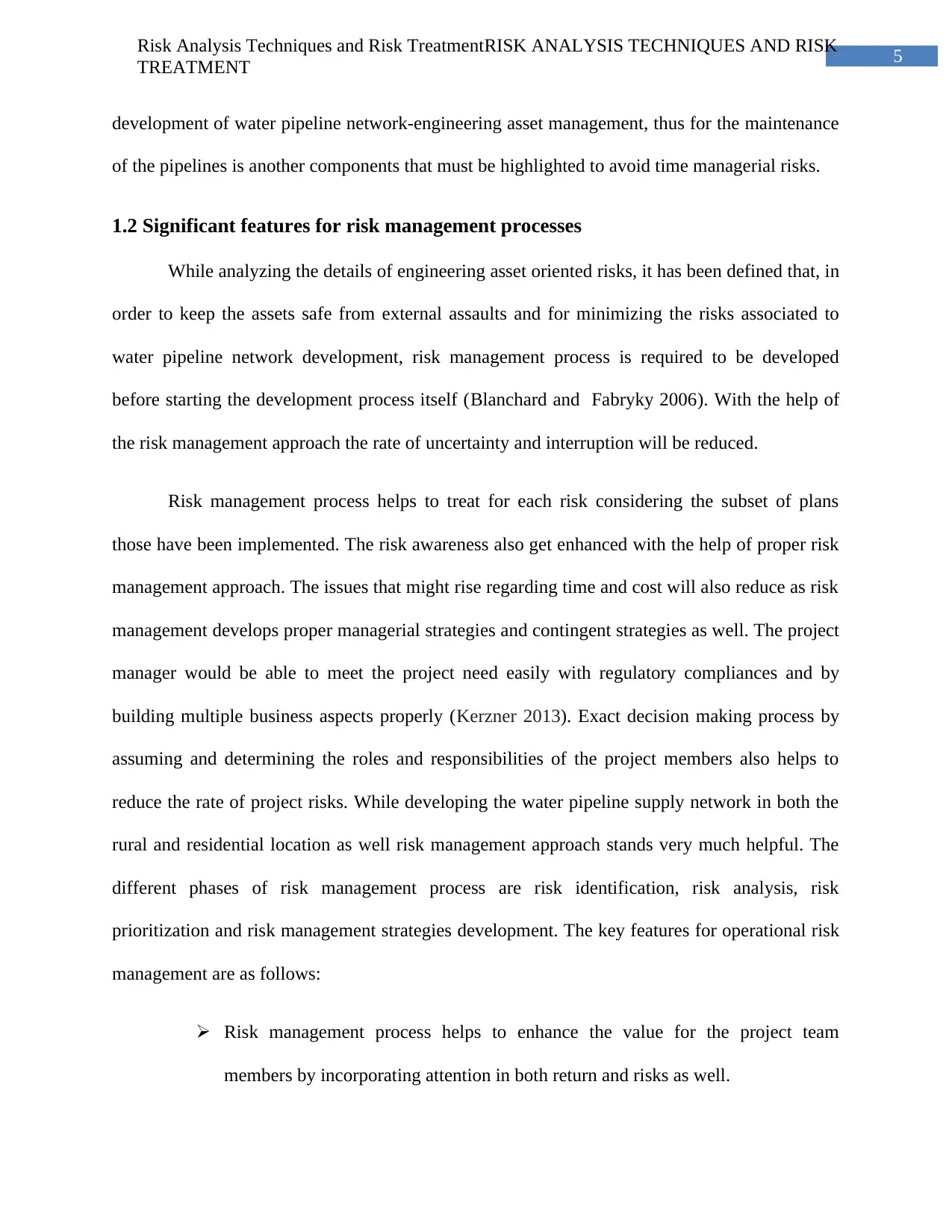
5
Risk Analysis Techniques and Risk TreatmentRISK ANALYSIS TECHNIQUES AND RISK
TREATMENT
development of water pipeline network-engineering asset management, thus for the maintenance
of the pipelines is another components that must be highlighted to avoid time managerial risks.
1.2 Significant features for risk management processes
While analyzing the details of engineering asset oriented risks, it has been defined that, in
order to keep the assets safe from external assaults and for minimizing the risks associated to
water pipeline network development, risk management process is required to be developed
before starting the development process itself (Blanchard and Fabryky 2006). With the help of
the risk management approach the rate of uncertainty and interruption will be reduced.
Risk management process helps to treat for each risk considering the subset of plans
those have been implemented. The risk awareness also get enhanced with the help of proper risk
management approach. The issues that might rise regarding time and cost will also reduce as risk
management develops proper managerial strategies and contingent strategies as well. The project
manager would be able to meet the project need easily with regulatory compliances and by
building multiple business aspects properly (Kerzner 2013). Exact decision making process by
assuming and determining the roles and responsibilities of the project members also helps to
reduce the rate of project risks. While developing the water pipeline supply network in both the
rural and residential location as well risk management approach stands very much helpful. The
different phases of risk management process are risk identification, risk analysis, risk
prioritization and risk management strategies development. The key features for operational risk
management are as follows:
Risk management process helps to enhance the value for the project team
members by incorporating attention in both return and risks as well.
Risk Analysis Techniques and Risk TreatmentRISK ANALYSIS TECHNIQUES AND RISK
TREATMENT
development of water pipeline network-engineering asset management, thus for the maintenance
of the pipelines is another components that must be highlighted to avoid time managerial risks.
1.2 Significant features for risk management processes
While analyzing the details of engineering asset oriented risks, it has been defined that, in
order to keep the assets safe from external assaults and for minimizing the risks associated to
water pipeline network development, risk management process is required to be developed
before starting the development process itself (Blanchard and Fabryky 2006). With the help of
the risk management approach the rate of uncertainty and interruption will be reduced.
Risk management process helps to treat for each risk considering the subset of plans
those have been implemented. The risk awareness also get enhanced with the help of proper risk
management approach. The issues that might rise regarding time and cost will also reduce as risk
management develops proper managerial strategies and contingent strategies as well. The project
manager would be able to meet the project need easily with regulatory compliances and by
building multiple business aspects properly (Kerzner 2013). Exact decision making process by
assuming and determining the roles and responsibilities of the project members also helps to
reduce the rate of project risks. While developing the water pipeline supply network in both the
rural and residential location as well risk management approach stands very much helpful. The
different phases of risk management process are risk identification, risk analysis, risk
prioritization and risk management strategies development. The key features for operational risk
management are as follows:
Risk management process helps to enhance the value for the project team
members by incorporating attention in both return and risks as well.
⊘ This is a preview!⊘
Do you want full access?
Subscribe today to unlock all pages.

Trusted by 1+ million students worldwide
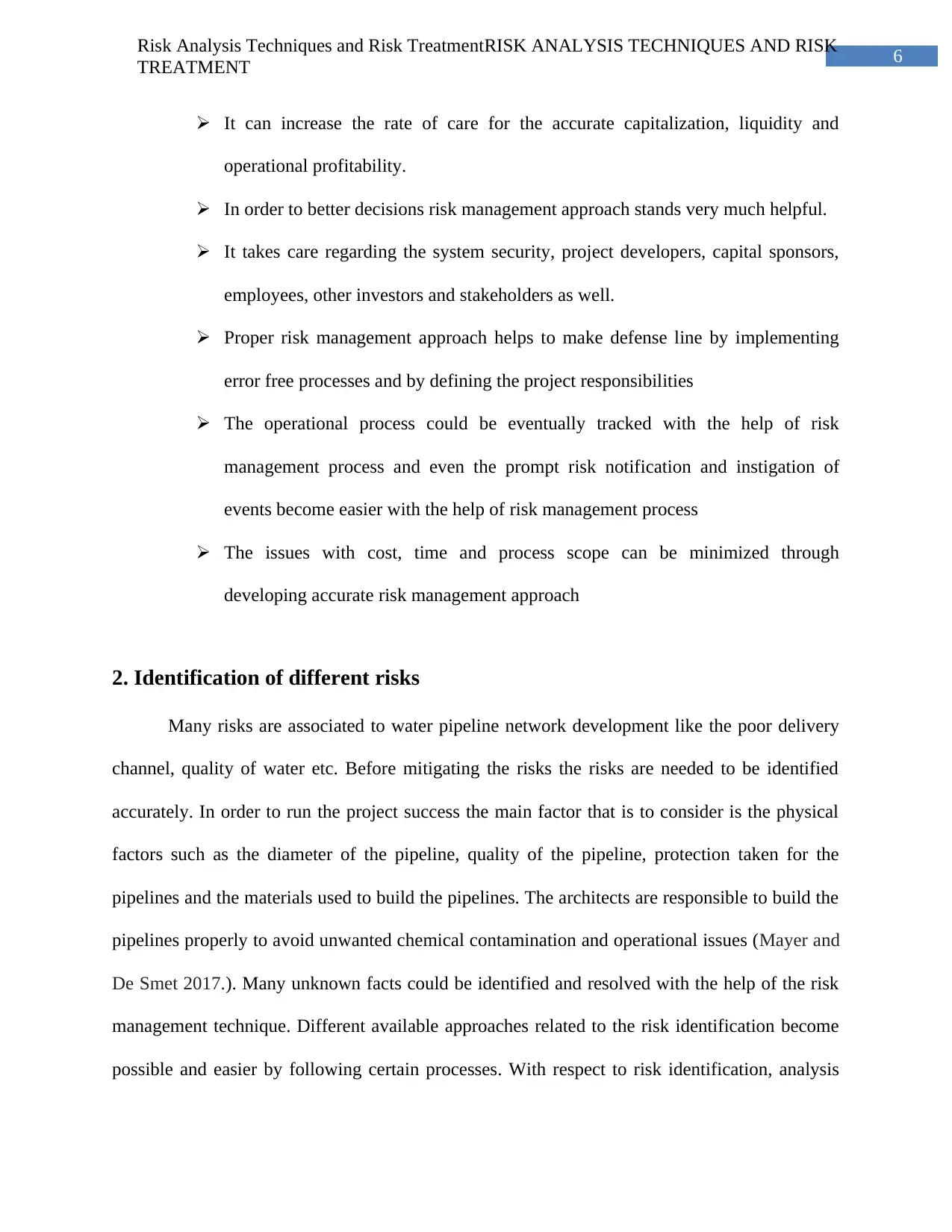
6
Risk Analysis Techniques and Risk TreatmentRISK ANALYSIS TECHNIQUES AND RISK
TREATMENT
It can increase the rate of care for the accurate capitalization, liquidity and
operational profitability.
In order to better decisions risk management approach stands very much helpful.
It takes care regarding the system security, project developers, capital sponsors,
employees, other investors and stakeholders as well.
Proper risk management approach helps to make defense line by implementing
error free processes and by defining the project responsibilities
The operational process could be eventually tracked with the help of risk
management process and even the prompt risk notification and instigation of
events become easier with the help of risk management process
The issues with cost, time and process scope can be minimized through
developing accurate risk management approach
2. Identification of different risks
Many risks are associated to water pipeline network development like the poor delivery
channel, quality of water etc. Before mitigating the risks the risks are needed to be identified
accurately. In order to run the project success the main factor that is to consider is the physical
factors such as the diameter of the pipeline, quality of the pipeline, protection taken for the
pipelines and the materials used to build the pipelines. The architects are responsible to build the
pipelines properly to avoid unwanted chemical contamination and operational issues (Mayer and
De Smet 2017.). Many unknown facts could be identified and resolved with the help of the risk
management technique. Different available approaches related to the risk identification become
possible and easier by following certain processes. With respect to risk identification, analysis
Risk Analysis Techniques and Risk TreatmentRISK ANALYSIS TECHNIQUES AND RISK
TREATMENT
It can increase the rate of care for the accurate capitalization, liquidity and
operational profitability.
In order to better decisions risk management approach stands very much helpful.
It takes care regarding the system security, project developers, capital sponsors,
employees, other investors and stakeholders as well.
Proper risk management approach helps to make defense line by implementing
error free processes and by defining the project responsibilities
The operational process could be eventually tracked with the help of risk
management process and even the prompt risk notification and instigation of
events become easier with the help of risk management process
The issues with cost, time and process scope can be minimized through
developing accurate risk management approach
2. Identification of different risks
Many risks are associated to water pipeline network development like the poor delivery
channel, quality of water etc. Before mitigating the risks the risks are needed to be identified
accurately. In order to run the project success the main factor that is to consider is the physical
factors such as the diameter of the pipeline, quality of the pipeline, protection taken for the
pipelines and the materials used to build the pipelines. The architects are responsible to build the
pipelines properly to avoid unwanted chemical contamination and operational issues (Mayer and
De Smet 2017.). Many unknown facts could be identified and resolved with the help of the risk
management technique. Different available approaches related to the risk identification become
possible and easier by following certain processes. With respect to risk identification, analysis
Paraphrase This Document
Need a fresh take? Get an instant paraphrase of this document with our AI Paraphraser
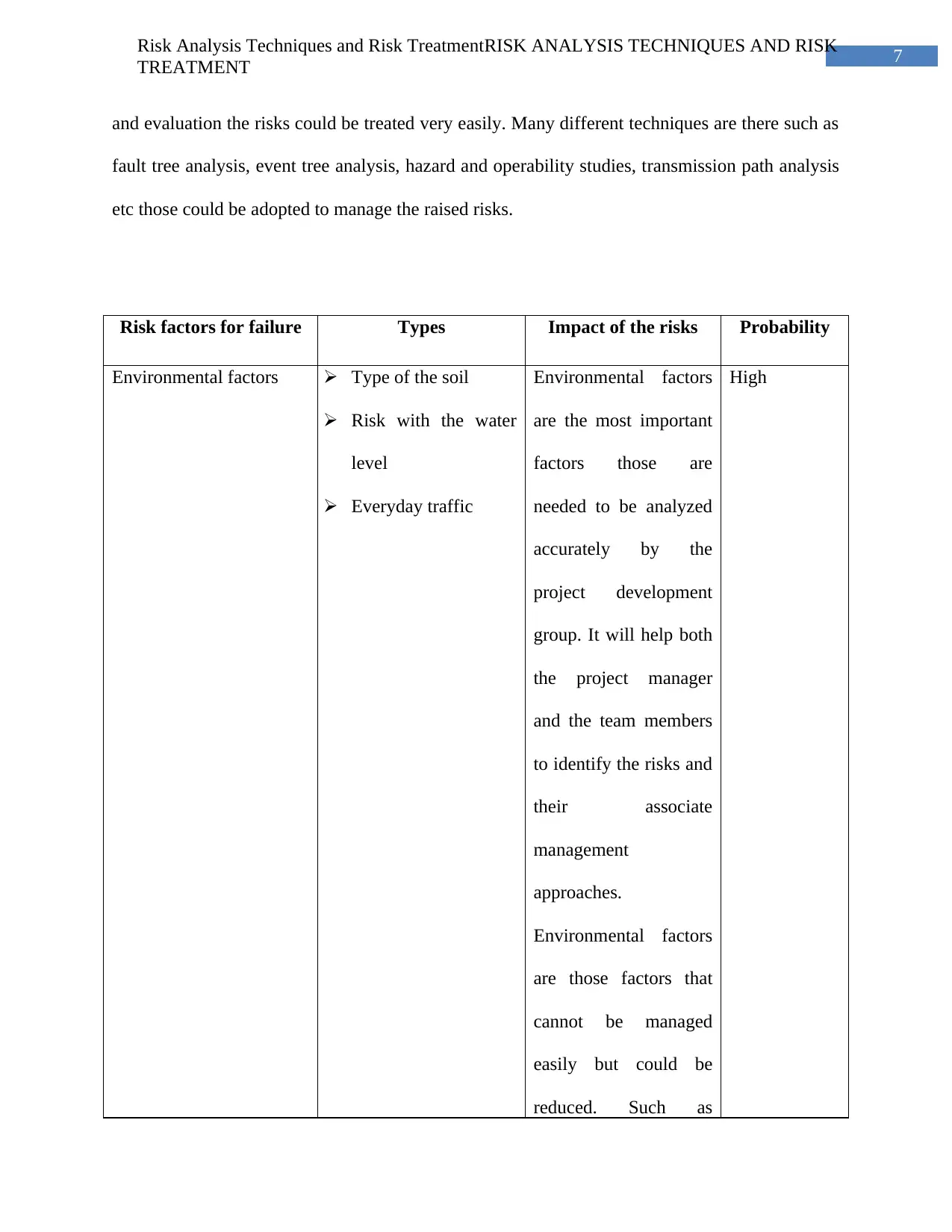
7
Risk Analysis Techniques and Risk TreatmentRISK ANALYSIS TECHNIQUES AND RISK
TREATMENT
and evaluation the risks could be treated very easily. Many different techniques are there such as
fault tree analysis, event tree analysis, hazard and operability studies, transmission path analysis
etc those could be adopted to manage the raised risks.
Risk factors for failure Types Impact of the risks Probability
Environmental factors Type of the soil
Risk with the water
level
Everyday traffic
Environmental factors
are the most important
factors those are
needed to be analyzed
accurately by the
project development
group. It will help both
the project manager
and the team members
to identify the risks and
their associate
management
approaches.
Environmental factors
are those factors that
cannot be managed
easily but could be
reduced. Such as
High
Risk Analysis Techniques and Risk TreatmentRISK ANALYSIS TECHNIQUES AND RISK
TREATMENT
and evaluation the risks could be treated very easily. Many different techniques are there such as
fault tree analysis, event tree analysis, hazard and operability studies, transmission path analysis
etc those could be adopted to manage the raised risks.
Risk factors for failure Types Impact of the risks Probability
Environmental factors Type of the soil
Risk with the water
level
Everyday traffic
Environmental factors
are the most important
factors those are
needed to be analyzed
accurately by the
project development
group. It will help both
the project manager
and the team members
to identify the risks and
their associate
management
approaches.
Environmental factors
are those factors that
cannot be managed
easily but could be
reduced. Such as
High
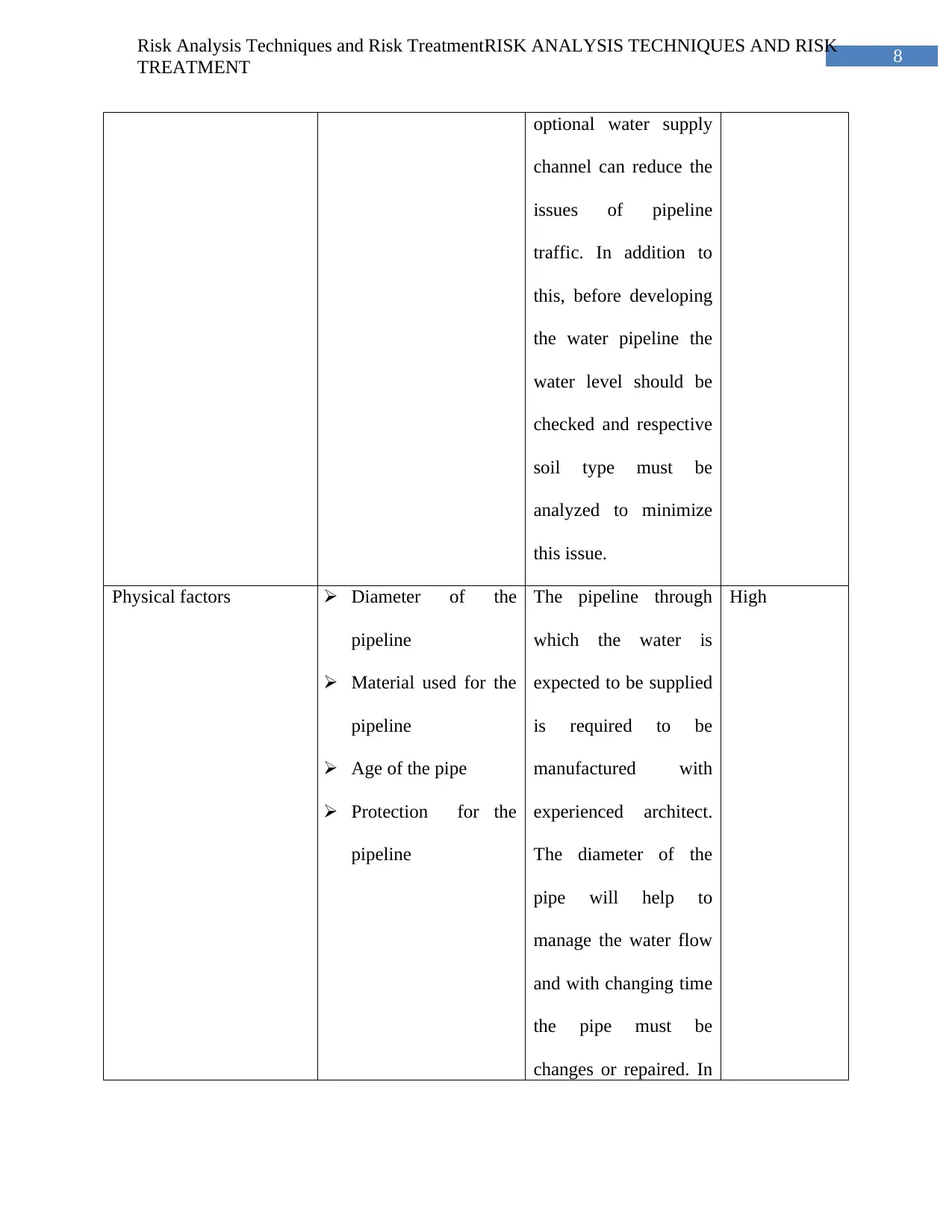
8
Risk Analysis Techniques and Risk TreatmentRISK ANALYSIS TECHNIQUES AND RISK
TREATMENT
optional water supply
channel can reduce the
issues of pipeline
traffic. In addition to
this, before developing
the water pipeline the
water level should be
checked and respective
soil type must be
analyzed to minimize
this issue.
Physical factors Diameter of the
pipeline
Material used for the
pipeline
Age of the pipe
Protection for the
pipeline
The pipeline through
which the water is
expected to be supplied
is required to be
manufactured with
experienced architect.
The diameter of the
pipe will help to
manage the water flow
and with changing time
the pipe must be
changes or repaired. In
High
Risk Analysis Techniques and Risk TreatmentRISK ANALYSIS TECHNIQUES AND RISK
TREATMENT
optional water supply
channel can reduce the
issues of pipeline
traffic. In addition to
this, before developing
the water pipeline the
water level should be
checked and respective
soil type must be
analyzed to minimize
this issue.
Physical factors Diameter of the
pipeline
Material used for the
pipeline
Age of the pipe
Protection for the
pipeline
The pipeline through
which the water is
expected to be supplied
is required to be
manufactured with
experienced architect.
The diameter of the
pipe will help to
manage the water flow
and with changing time
the pipe must be
changes or repaired. In
High
⊘ This is a preview!⊘
Do you want full access?
Subscribe today to unlock all pages.

Trusted by 1+ million students worldwide
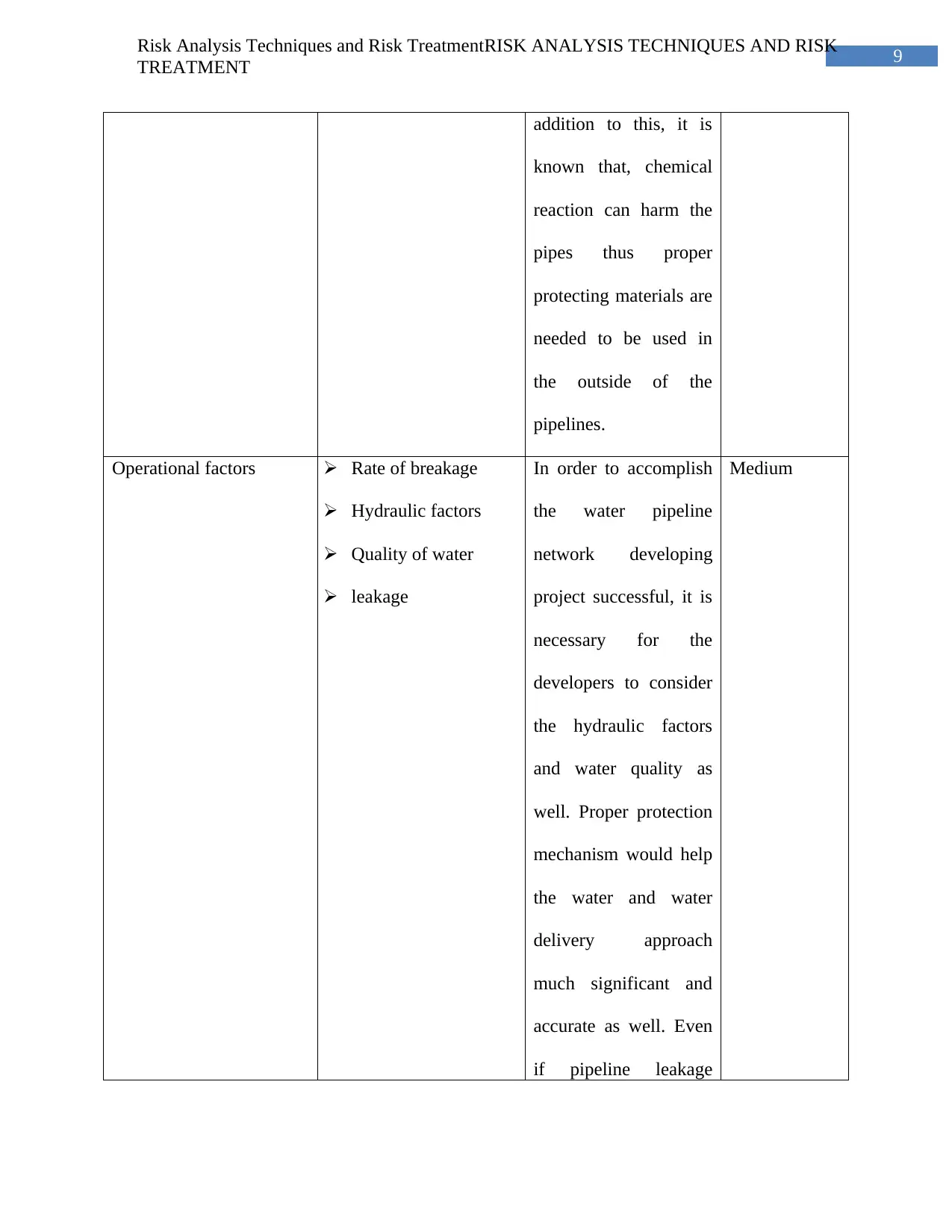
9
Risk Analysis Techniques and Risk TreatmentRISK ANALYSIS TECHNIQUES AND RISK
TREATMENT
addition to this, it is
known that, chemical
reaction can harm the
pipes thus proper
protecting materials are
needed to be used in
the outside of the
pipelines.
Operational factors Rate of breakage
Hydraulic factors
Quality of water
leakage
In order to accomplish
the water pipeline
network developing
project successful, it is
necessary for the
developers to consider
the hydraulic factors
and water quality as
well. Proper protection
mechanism would help
the water and water
delivery approach
much significant and
accurate as well. Even
if pipeline leakage
Medium
Risk Analysis Techniques and Risk TreatmentRISK ANALYSIS TECHNIQUES AND RISK
TREATMENT
addition to this, it is
known that, chemical
reaction can harm the
pipes thus proper
protecting materials are
needed to be used in
the outside of the
pipelines.
Operational factors Rate of breakage
Hydraulic factors
Quality of water
leakage
In order to accomplish
the water pipeline
network developing
project successful, it is
necessary for the
developers to consider
the hydraulic factors
and water quality as
well. Proper protection
mechanism would help
the water and water
delivery approach
much significant and
accurate as well. Even
if pipeline leakage
Medium
Paraphrase This Document
Need a fresh take? Get an instant paraphrase of this document with our AI Paraphraser
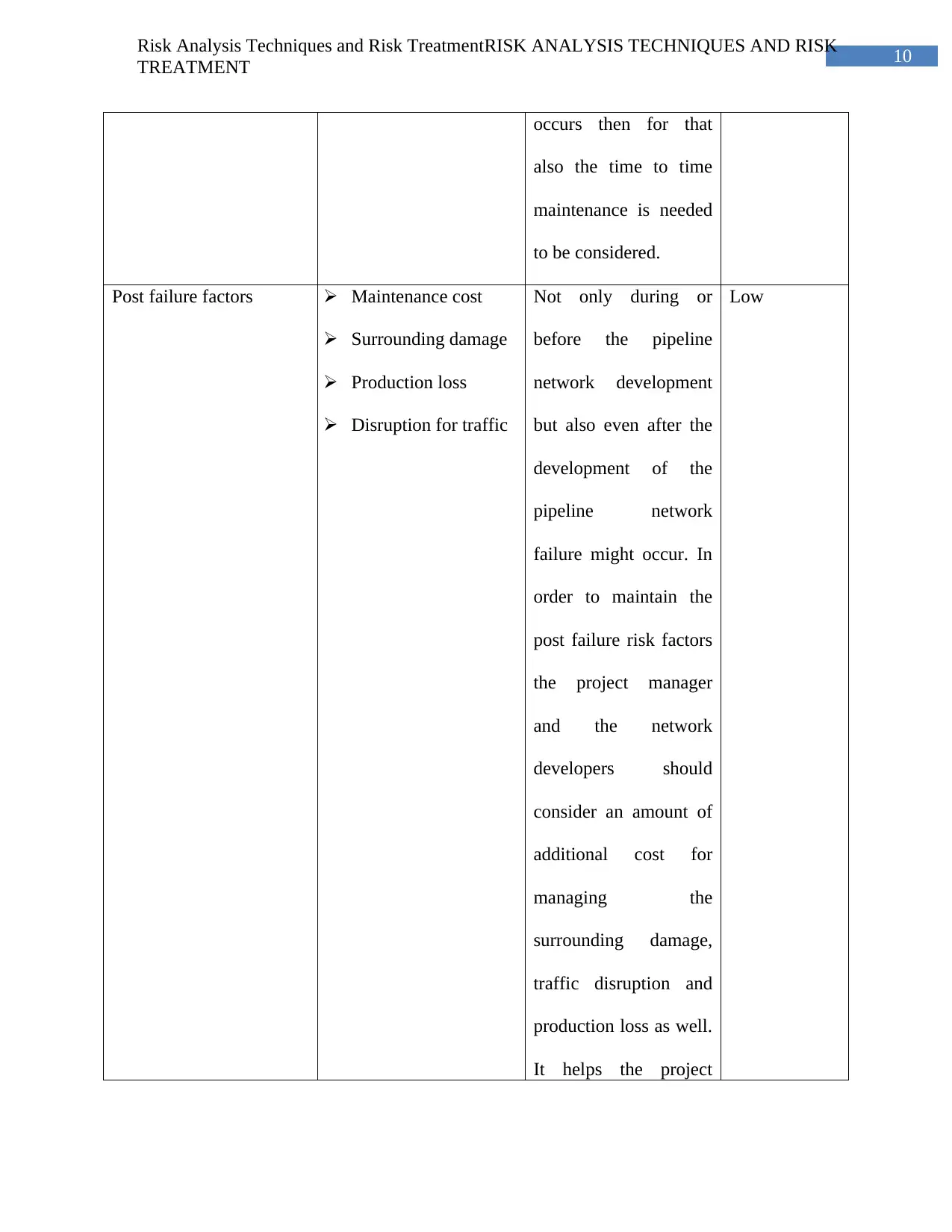
10
Risk Analysis Techniques and Risk TreatmentRISK ANALYSIS TECHNIQUES AND RISK
TREATMENT
occurs then for that
also the time to time
maintenance is needed
to be considered.
Post failure factors Maintenance cost
Surrounding damage
Production loss
Disruption for traffic
Not only during or
before the pipeline
network development
but also even after the
development of the
pipeline network
failure might occur. In
order to maintain the
post failure risk factors
the project manager
and the network
developers should
consider an amount of
additional cost for
managing the
surrounding damage,
traffic disruption and
production loss as well.
It helps the project
Low
Risk Analysis Techniques and Risk TreatmentRISK ANALYSIS TECHNIQUES AND RISK
TREATMENT
occurs then for that
also the time to time
maintenance is needed
to be considered.
Post failure factors Maintenance cost
Surrounding damage
Production loss
Disruption for traffic
Not only during or
before the pipeline
network development
but also even after the
development of the
pipeline network
failure might occur. In
order to maintain the
post failure risk factors
the project manager
and the network
developers should
consider an amount of
additional cost for
managing the
surrounding damage,
traffic disruption and
production loss as well.
It helps the project
Low
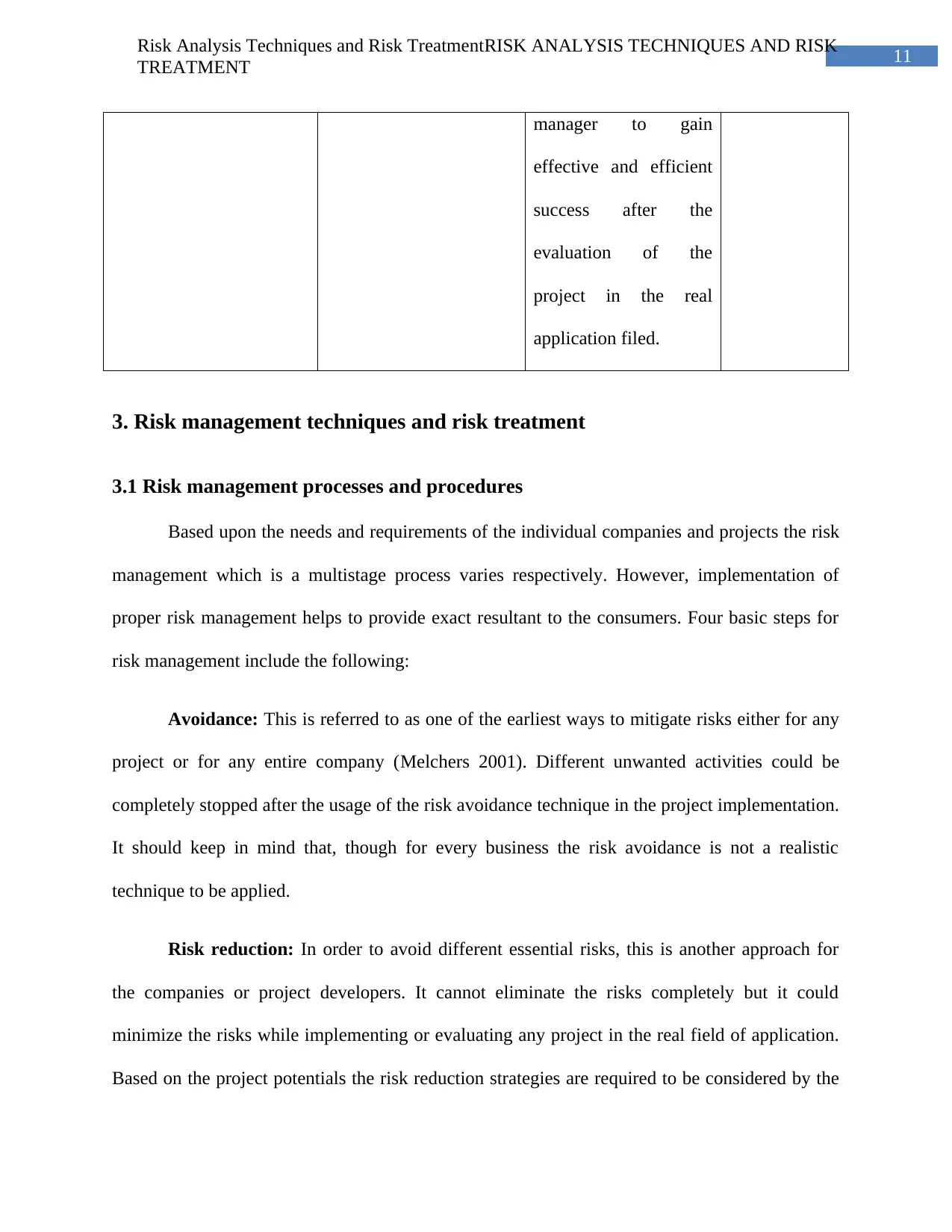
11
Risk Analysis Techniques and Risk TreatmentRISK ANALYSIS TECHNIQUES AND RISK
TREATMENT
manager to gain
effective and efficient
success after the
evaluation of the
project in the real
application filed.
3. Risk management techniques and risk treatment
3.1 Risk management processes and procedures
Based upon the needs and requirements of the individual companies and projects the risk
management which is a multistage process varies respectively. However, implementation of
proper risk management helps to provide exact resultant to the consumers. Four basic steps for
risk management include the following:
Avoidance: This is referred to as one of the earliest ways to mitigate risks either for any
project or for any entire company (Melchers 2001). Different unwanted activities could be
completely stopped after the usage of the risk avoidance technique in the project implementation.
It should keep in mind that, though for every business the risk avoidance is not a realistic
technique to be applied.
Risk reduction: In order to avoid different essential risks, this is another approach for
the companies or project developers. It cannot eliminate the risks completely but it could
minimize the risks while implementing or evaluating any project in the real field of application.
Based on the project potentials the risk reduction strategies are required to be considered by the
Risk Analysis Techniques and Risk TreatmentRISK ANALYSIS TECHNIQUES AND RISK
TREATMENT
manager to gain
effective and efficient
success after the
evaluation of the
project in the real
application filed.
3. Risk management techniques and risk treatment
3.1 Risk management processes and procedures
Based upon the needs and requirements of the individual companies and projects the risk
management which is a multistage process varies respectively. However, implementation of
proper risk management helps to provide exact resultant to the consumers. Four basic steps for
risk management include the following:
Avoidance: This is referred to as one of the earliest ways to mitigate risks either for any
project or for any entire company (Melchers 2001). Different unwanted activities could be
completely stopped after the usage of the risk avoidance technique in the project implementation.
It should keep in mind that, though for every business the risk avoidance is not a realistic
technique to be applied.
Risk reduction: In order to avoid different essential risks, this is another approach for
the companies or project developers. It cannot eliminate the risks completely but it could
minimize the risks while implementing or evaluating any project in the real field of application.
Based on the project potentials the risk reduction strategies are required to be considered by the
⊘ This is a preview!⊘
Do you want full access?
Subscribe today to unlock all pages.

Trusted by 1+ million students worldwide
1 out of 25
Related Documents
Your All-in-One AI-Powered Toolkit for Academic Success.
+13062052269
info@desklib.com
Available 24*7 on WhatsApp / Email
![[object Object]](/_next/static/media/star-bottom.7253800d.svg)
Unlock your academic potential
Copyright © 2020–2025 A2Z Services. All Rights Reserved. Developed and managed by ZUCOL.




